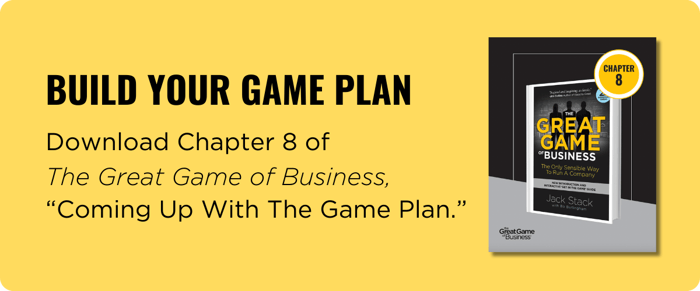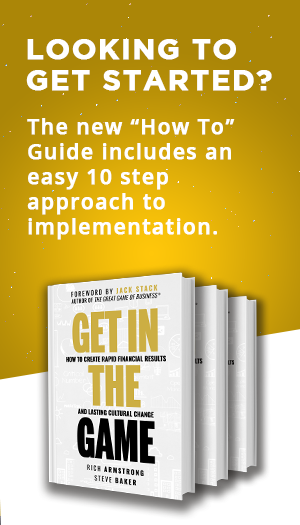.png?width=1200&name=the_4_cs%20(1).png)
As you likely know, forecasting is an integral part of what we do at SRC Holdings Corporation. We come together twice a year to create a plan of what our organization will look like one year out, five years out, and even 10 years into the future. This is where our organization can, according to the legendary business writer Jim Collins, identify its BHAGs – or big hairy audacious goals.
Whenever we wrap these meetings, there’s almost always a sense of euphoria among us: “Wow! We are going to accomplish some great things together!” It's incredible to see everyone excited about where we’re headed together and what we plan to accomplish.
But I want to push the pause button here for a minute because this is where a lot of organizations get tripped up.
Putting your targets out there isn’t the conclusion. It’s just the beginning.
It’s one thing to listen to your sales team about the kind of potential that’s out there for your organization and all the BHAGs you want to chase down. But it’s another thing altogether to focus on the details about how you will be able to execute on that plan.

Do you have the people, the building space, and the raw materials to hit those targets? Do you have the necessary engineering talent, quality control and IT systems as well as the necessary cash in place to execute on your plan? Have you taken your sales plan and turned it into a financial plan, an income statement that shows how you can actually account for the various costs and expenses you’ll incur while still making a profit on your way to hitting your goals?
You need to embrace what I call “creative paranoia,” meaning you also should be asking yourself the kinds of questions that will help you accomplish your goals even if a worst-case scenario unfolds.
If you haven’t addressed questions like these, then you haven’t really created a plan you know you can tackle with confidence. That’s where the Four C's – Capabilities, Capacity, Constraints and Culture – come into play.
Capabilities
Your capabilities are your people, the associates you have invested in that make up your team. When you put your plan together, are you asking, as Collins also wrote, whether you have the right people on the bus? Do you have the people with the skill-sets you need to launch that new product line you envision? If not, how do you intend to get them?
Capacity
Capacity is a critical element in that it tells you how efficient your organization is at turning inputs into outputs. You need to ask what your current capacity is and whether your organization has the capacity to increase its output relative to your five and ten-year plans. If not, what do you need to do to get it there?
Constraints
Similarly, what constraints might the organization run into in trying to hit its goals? In particular, I like to focus on the one thing that could happen that would bring your whole plan down. If you’re relying on a single machine, for example, do you have a plan for when, not if, it breaks down? What’s your business contingency plan? Is there someone out there capable of fixing it? Or, if not, do you have the cash on hand you’ll need to replace it?
Culture
The fourth element for you to consider in your long-term planning is whether you have the kind of culture that can ask these kinds of questions and absorb the answers. If you don’t have the necessary teamwork, collaboration, and optimism capable of executing on the details of the plan, while also developing the backup plans in place to support it, then the whole thing will likely go to hell in a handbasket.
Let’s say you want to double your business in five years. And to do that, you determine that you need to add 65 people to your team. Simple enough, right? Ahh – but you only have room for 50 parking spots. How do you handle that in your plan? Or, let’s say that the growth will result from manufacturing a smaller engine. Only, the new product takes fewer people to make it. So what are you going to do with all those extra people standing around with nothing to do once you make the transition? How does your plan account for making sure they don’t lose their jobs?
What’s interesting is that we’ve found that the further you forecast and plan into the future, the more critical these Four C’s become. The trick is to think about how the present extends into the future. You need to lead in such a way that people begin to think beyond their day-to-day activities and begin to look at the big picture as well.

The point is that long-term business planning is far more involved than just throwing up hairy and audacious numbers. You need to take the next steps by asking: What is my team capable of? What is our capacity? What are our constraints? And how strong is our culture?
And if you don’t find the answers you need, then your plan wasn’t worth much in the first place.
Want an inside look at SRC’s annual planning process? Attend Great Game’s High-Involvement Planning Workshop to learn how to transform your annual financial & strategic planning process into one that addresses the Four C's as Jack mentions in this article.

Other articles you might like:
.png)



.jpg)




.png)




-5.png)

